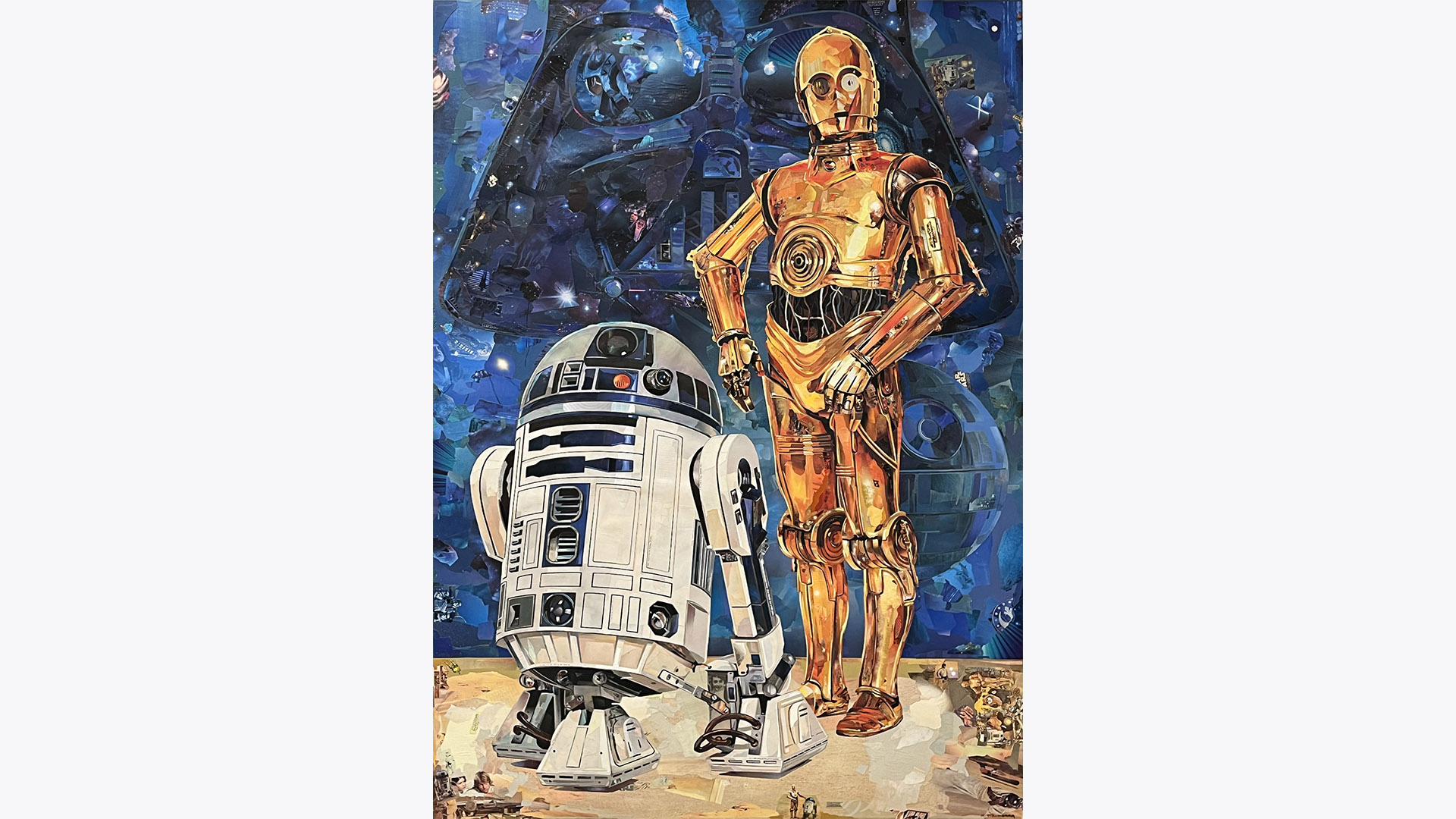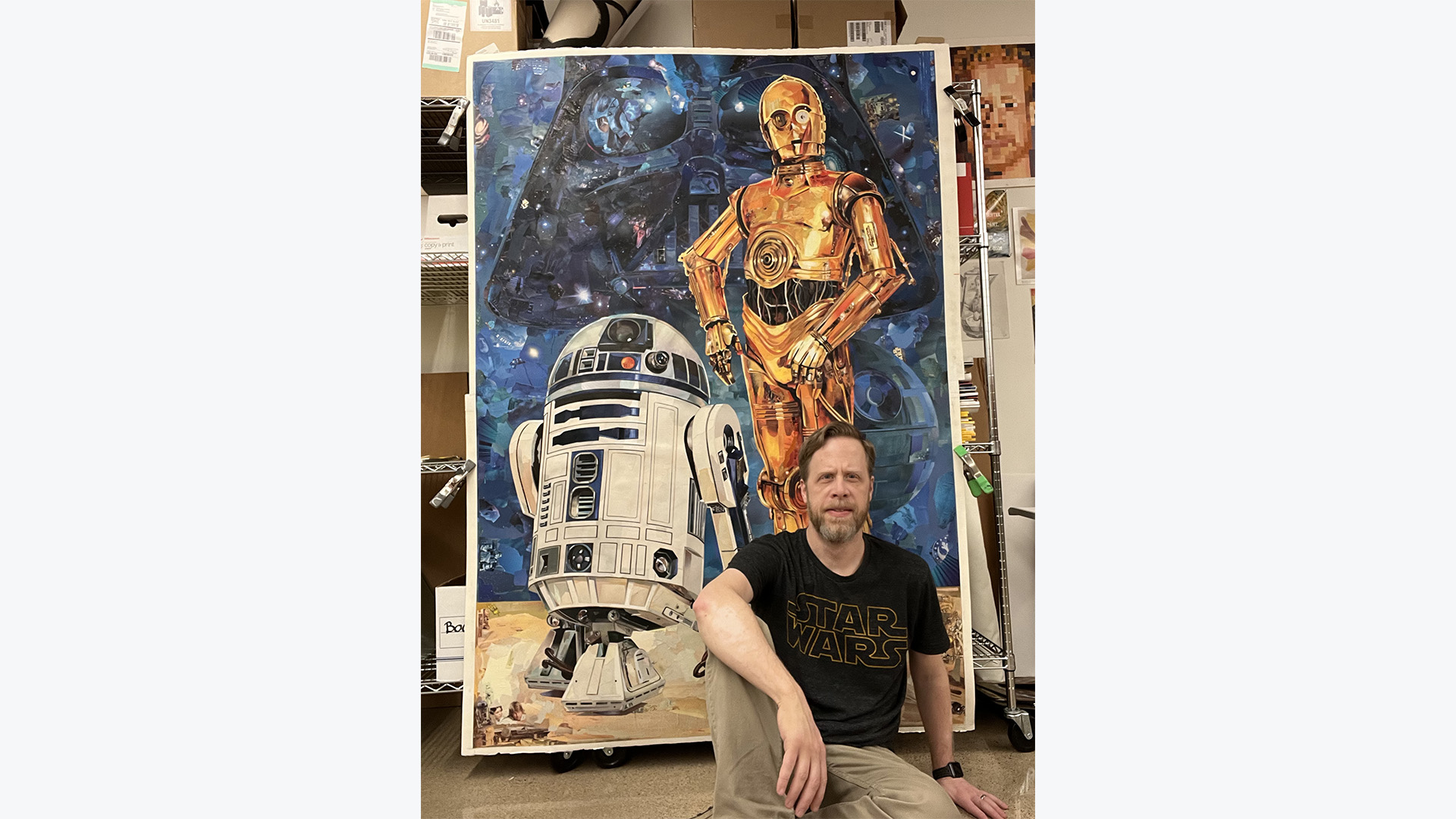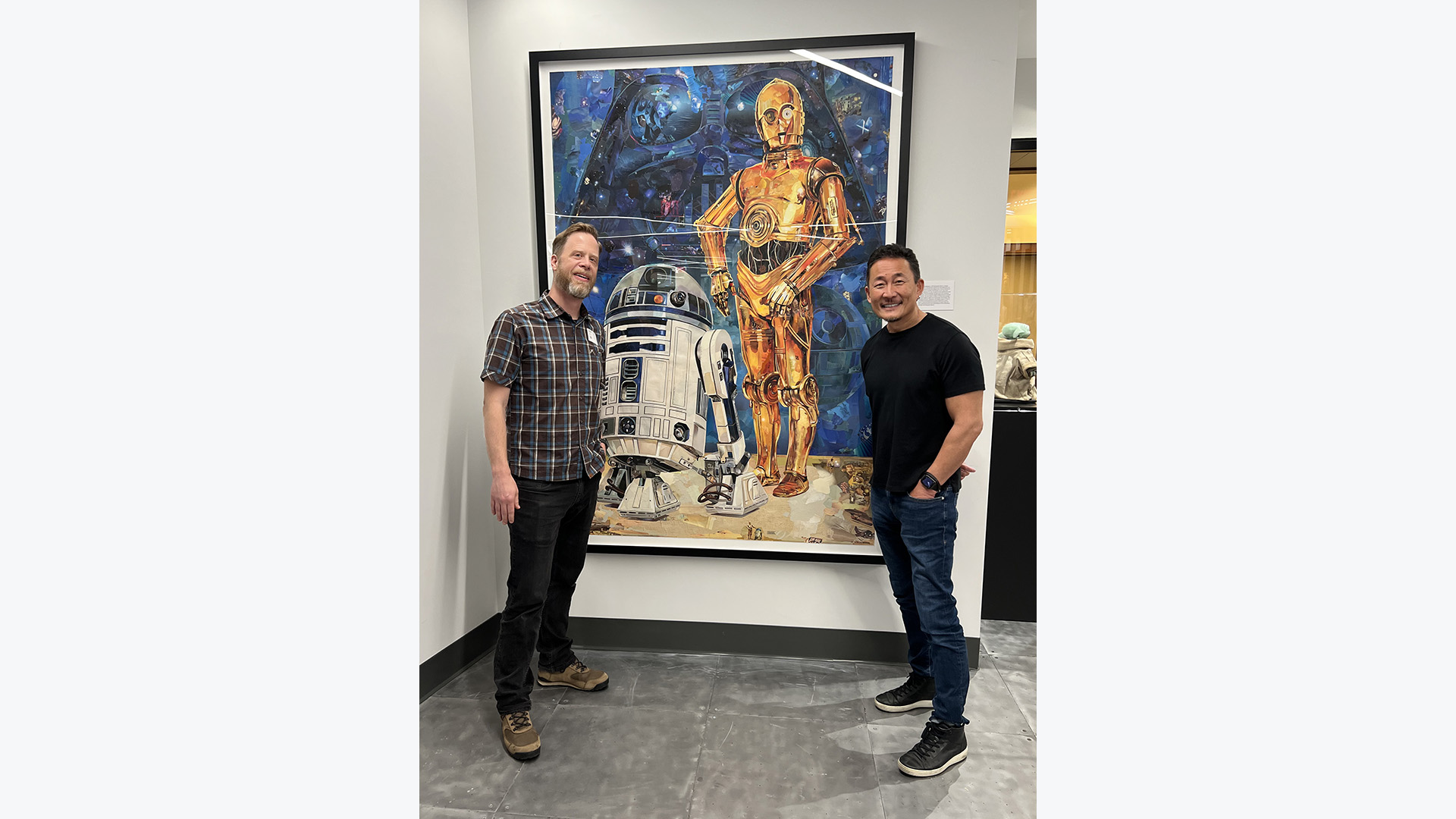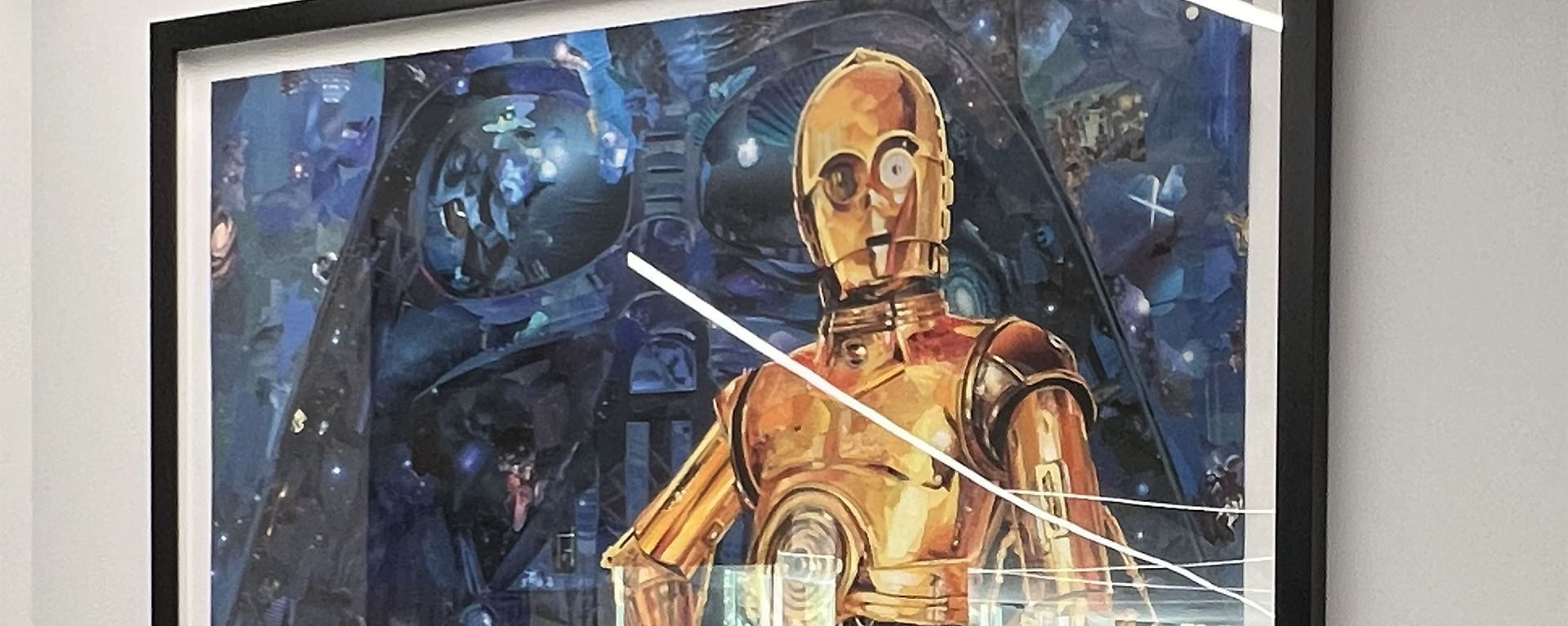The Making of a New Lucasfilm Art Installation with Artist Nathan Stromberg
The Minnesota-based artist was commissioned to create a unique piece for Lucasfilm’s San Francisco headquarters.
Employees and visitors to our Lucasfilm headquarters in San Francisco have been enjoying a new art installation that was specially-commissioned for a wall near the main entrance. From afar, it appears to be a large painting of R2-D2 and C-3PO, the iconic droids who first appeared in Star Wars: A New Hope (1977). But as they step closer, it’s revealed to be thousands of small pieces of paper cut and pasted together to create an elaborate collage.

Minnesota artist and teacher Nathan Stromberg created this unique work, which is inspired by a classic 1977 poster and later adapted as a cover for the Star Wars storybook and read-along record. As a lifelong fan, Stromberg would’ve known the image as a child.
“To anybody from my generation, how could you not be a Star Wars fan?” he tells Lucasfilm.com. “I was born in 1978, too young to see the movies in their original run. The first movie I saw in the theater was E.T. in 1982, but pretty early on, we had the Star Wars VHS tapes. I’d come home from school and often put a Star Wars or Indiana Jones movie on. I was absolutely obsessed with both.”
Fond of drawing and crafts from a young age, Stromberg received important inspiration from Star Wars in particular. One of his early VHS tapes included the behind-the-scenes documentary, From Star Wars to Jedi. “I loved that as much as I did the actual movies,” Stromberg recalls. “There was a clip of the guys in the parking lot filming the trench run model from the back of a truck. You’d see Phil Tippett animating tauntauns and AT-ATs. For the longest time, when people asked me what I wanted to do when I grew up, I’d say that I’d love to work in special effects.
“Star Wars has always been about creativity,” Stromberg continues. “They’re these grand stories in a galaxy far, far away. It taught a whole generation of kids how to dream, think big, and revel in these stories. It taught me how to be creative, the whole idea of making stuff.”
In college, Stromberg majored in both art and art education. Finishing his degree, he explains that he “wasn’t ready to try and became a professional artist and enter that highly competitive world. I knew I loved doing it, but I had to figure out another way to make a living by doing it.” He began teaching in 2002, and eventually became a professional artist as well, honing his craft and vision while in graduate school, which he completed in 2010 with an emphasis in oil painting.
“I have my day job teaching, and my job as an artist on nights and weekends,” Stromberg says. “I’m always trying to learn and get better. I put in a huge amount of time to get to where I am now, and I want to keep improving.” He finds creative outlets both as a teacher and in his personal work for exhibitions and commissions, and even makes time to help create stage scenery, props, and puppets for his school’s theater productions. Stromberg explains that his home in the Twin Cities of Minneapolis and St. Paul has a rich and vibrant arts community, perhaps in part as a result of the increased time indoors during winter, which he notes with a smile.
His passion for collage, however, is a relatively new development in his artistic journey. “I’m very interested in everything,” Stromberg says. “That might be one of the reasons why I wasn’t quite ready to go off and be a professional when I finished college. I’ve sculpted, done woodshop and industrial work, oil painting, watercolor painting, children’s books, and printmaking. I was pretty good at everything but not fantastic at anything because I was too curious about lots of different things. When I did my MFA work, I doubled down on oil painting, and was playing around a lot with nostalgic imagery.
“I based some of my painting on found slide film,” he continues. “People go to estate sales and purchase boxes of old Kodachrome slides, beautiful color images. You see other people’s memories in them. Something struck me about the connection this has to the American experience and the whole way we perceive time. I think that was the genesis for what eventually became my uses of things for collage, these bits of dated imagery.”
Inspiration struck during a home renovation project, when Stromberg was ripping out the floor in his attic. Below, he discovered heaps of 1940’s newspaper, which at the time was commonly used for insulation. “It was too cool to get rid of,” he says. “I wanted to use it somehow, but didn’t know how to do it.” Further inspiration came from celebrated artist Jasper Johns, who layered his canvases with newspapers and then covered them with paint or caustic wax. “It looks like red and white stripes from afar, but when you get close, you see the newspapers in there. I thought that maybe I could do that. Take pieces of the newspaper, paint over with oil paints, and then you’d see the bits of context that could provide an extra layer of meaning.”
Stromberg chose a picture of a classic car as his reference, then organized the dark and light sections of the black and white newspapers. Irony had its moment when he began to paint colors over the material, only to discover that it diluted the powerful effect of the newspaper. Instead, he’d work solely with the found material. “I treated the bits of paper, in the way I cut them and layered light and dark values next to each other, the same way that I would treat paint,” Stromberg says. “The real challenge is that it took an extremely long time to figure out how to do it.” He’d spend some two years focusing exclusively on making car images from vintage newspapers.
Having found his breakthrough medium, the next logical stage was to make collages in color. “With black and white, you mix the darks together and the lights together,” Stromberg says, “but with color, you have to find the right kinds of a certain color. If you need a light blue, it has to be a blue that isn’t too yellow or too purple. It takes a lot longer. That’s how the idea of trying to use period paper came about. Wouldn’t it be most interesting if when I’m depicting an object from 1953, I used magazines from 1953? The bits of type and colors would translate somehow.”
An early success was a commissioned piece of a 1971 Kawasaki motorcycle, which Stromberg depicted with contemporaneous materials. But over time, he’d discover the limitations of working with historic paper, itself often not intended to be glued or displayed under light for extended periods. “Some of the earliest pieces I’ve done have faded,” he notes. “Bright blues turn gray. Bright reds turn orange. It’s frustrating. So now I often take old images, scan them, reprint them on archival paper, and then cut them up. That’s really time consuming. I also will find high quality, coffee-table books of older images. There are books of posters from the 1950s, for example, and I can cut those up.”
Stromberg’s Lucasfilm commission uses a mix of different materials, including Star Wars posters, magazines, and book illustrations (a number of which came from another of Stromberg’s attic finds: a box containing his childhood books and PrestoMagic sets). “The Lucasfilm team was very open in terms of what I’d like to do,” he says. “I knew that I wanted an original trilogy version of something, since I’d had those early books, and given my age, it has the most meaning to me. Lucasfilm then suggested some ideas. It seemed like doing a life-size R2-D2 and C-3PO was the way to go.” The demanding scale would result in Stromberg’s biggest collage to date, standing nearly five feet wide and seven feet tall.

The artist notes that the original 1977 poster image that inspired the artwork “had a blue background with a kind of cream color at the bottom,” as he puts it. “So I thought that the top could be a starfield with a Tatooine, sandy style at the bottom. As I started, I realized that there was a lot of blue at the top, and it’d be nice to have something else in there. So I tried a digital mock-up of a Darth Vader helmet, and that was approved. Having Artoo, Threepio, and Vader in the background gave me a ton of options to disguise things within the design.”
Among the more elaborate details hidden within the collage can be found in C-3PO’s right hand. “It was difficult to determine the right shapes for his knuckles based on the original image,” Stromberg explains. “So I could try to do research and find a different picture and make the bits in Threepio’s hand exactly as they are, which I did for a couple of things. But I also took entire little pictures of C-3PO and used those as the knuckles. When you see it from farther away, it all blends together. It’s like hiding things in plain sight.”
Elsewhere there are small photographs of R2-D2 actor Kenny Baker, C-3PO actor Anthony Daniels, and George Lucas. Darth Vader’s helmet, looming over the entire piece from the upper background, contains a subtle image of Luke Skywalker (taken from another storybook) within the Sith Lord’s eye. “It was an incredible find,” as Stromberg comments, “and you have Luke’s image inside his father’s helmet. That’s the story.” He even cut thin strips of text from one storybook and used them to help add more definition to the white surface of R2-D2’s body.
Altogether, Stromberg spent a little over three months on the collage, breaking it up into two halves to allow it to fit within the relatively tight space of his home studio. Balancing the task with his day job, some 211 hours of labor, mostly nights and weekends, went into the piece. “In the early days when I was trying to figure out how to do it, I’d spend hundreds of hours on a piece that was 18 by 24 inches,” he explains. “Now, I’ve gotten to the point where I trust my instincts. One of the challenges when you’re working on things that are really big is that you can hide lots of images within it, but it gets to be so many images that sometimes it can just take forever. The challenge is to put something down, see how it works, step back from it, and make any adjustments and keep layering it. I made the entire thing with the colors first.”
The result is both a mesmerizing representation of some of the most enduring icons of the Star Wars saga, icons that cross the many generations who have come to love it. The artwork itself is the kind of multi-layered wonder that rewards repeat observations, including from many of Lucasfilm’s own seasoned artists. For Stromberg, the experience making it encapsulates his own passion in using the imagery and materials of the past to help us contemplate the future.

“I’ve been thinking about what will be sacred from today?” he comments. “Something will be, but it will be different. Part of it is I’m getting older. I work with teenagers a lot, and I’ve been teaching longer than they’ve been alive. Popular culture is different now, no matter what it is. There’s more amazing stuff being made now than ever before, but the mono-culture doesn’t exist anymore. Star Wars was something that everyone watched and was aware of. It’s an understatement to say that it was a full societal phenomenon. It transformed my generation. But it makes me wonder what in the future is going to be important and essential? I’m interested in objects from the past, the way people look at the past, and how the past is never something static or the same for every person.
“When I was doing my grad work using old film stills, some people would see the material as dated, bygone things, symbols from another time, and they were glad we’d moved forward. Then somebody else would say that it reminded them of their mother or something like that, deeply personal memories. That’s ripe for art-making. I don’t want to be in a place where I’m telling someone exactly what to think about. I love just putting it out there and seeing how people approach it. Specifically with Star Wars, we all have our own memories and associations that we bring to it.
“People love these characters. I would reject the idea that the art is sentimental. Perhaps it’s about looking for things that have greater significance and meaning that we might give them credit for. Some people might say R2-D2 and C-3PO are just characters from a movie, what’s the big deal? To me, they’re like friends. There’s real power in what they mean to people. And they were created by artists as movie characters who I can’t imagine they knew at the time how transformative they’d be. I like the idea of putting something out there to help us celebrate, remember, and chronicle. It’s deeply rooted in this curiosity about what is going to be sacred in the future.”
Lucas O. Seastrom is a writer and historian at Lucasfilm.
—
Lucasfilm | Timeless stories. Innovative storytelling.

